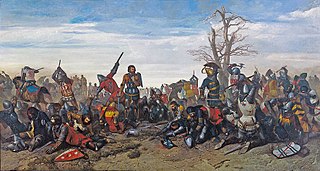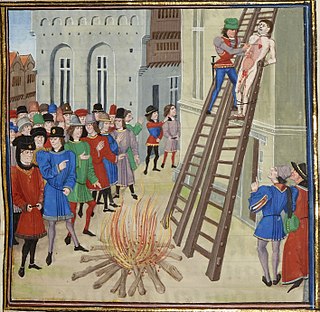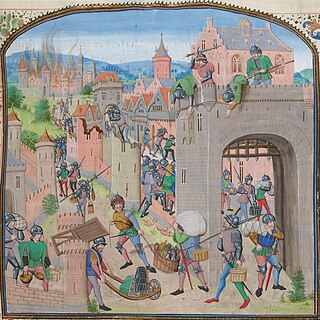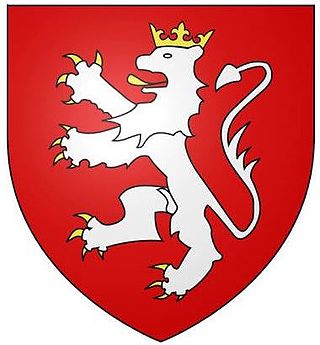
Joanna of Bourbon was Queen of France by marriage to King Charles V. She acted as his political adviser and was appointed potential regent in case of a minor regency.
Captal de Buch was a medieval feudal title in Gascony held by Jean III de Grailly among others.

The Combat of the Thirty, occurring on 26 March 1351, was an episode in the Breton War of Succession fought to determine who would rule the Duchy of Brittany. It was an arranged fight between selected combatants from both sides of the conflict, fought at a site midway between the Breton castles of Josselin and Ploërmel among 30 champions, knights, and squires on each side. The challenge was issued by Jean de Beaumanoir, a captain of Charles of Blois supported by King Philip VI of France, to Robert Bemborough, a captain of Jean de Montfort supported by Edward III of England.

Charles of Blois-Châtillon, nicknamed "the Saint", was the legalist Duke of Brittany from 1341 until his death, via his marriage to Joan, Duchess of Brittany and Countess of Penthièvre, holding the title against the claims of John of Montfort. The cause of his possible canonization was the subject of a good deal of political maneuvering on the part of his cousin, Charles V of France, who endorsed it, and his rival, Montfort, who opposed it. The cause fell dormant after Pope Gregory XI left Avignon in 1376, but was revived in 1894. Charles of Blois was beatified in 1904.

Charles du Fresne, sieur du Cange, also known simply as Charles Dufresne, was a distinguished French philologist and historian of the Middle Ages and Byzantium.

Froissart's Chronicles are a prose history of the Hundred Years' War written in the 14th century by Jean Froissart. The Chronicles open with the events leading up to the deposition of Edward II in 1326, and cover the period up to 1400, recounting events in western Europe, mainly in England, France, Scotland, the Low Countries and the Iberian Peninsula, although at times also mentioning other countries and regions such as Italy, Germany, Ireland, the Balkans, Cyprus, Turkey and North Africa.
Philippe Mouskes was the author of a rhymed chronicle that draws on the history of the Franks and France, from the origins until 1242.
Tard-Venus were medieval groups of routiers that ravaged Europe in the later years of the reign of King John II of France.

Hagre l'Escot was a Scottish mercenary captain during the Hundred Years War.

Francois Hennequin, was a mercenary captain during the Hundred Years War.

Naudon de Bageran, was a mercenary captain during the Hundred Years War.

Robert Birkhead (Briquet) was a mercenary captain during the Hundred Years War.

John Creswey, was a mercenary captain during the Hundred Years War and was an Englishman.

Bernard de la Salle, was a French mercenary captain during the Hundred Years War. His story is mentioned in the Chronicles of Froissart
Bernard de Wisk was a mercenary captain and sometime brigand of the Hundred Years War.

Bour de Breteuil was a Mercenary captain of the Hundred Years War.

Bour Camus, or Camus Bour Lesparre, also known as Camus the Bastard was a mercenary captain during the Hundred Years War. He was of Navarrese or Gascon origin.

Olivier IV de Clisson (1300–1343), was a Breton Marche Lord and knight who became embroiled in the intrigue of Vannes and was subsequently executed by the King of France for perceived treason. He was the husband of Jeanne de Clisson who eventually became known as the Lioness of Brittany.

Louis de Laval was a French nobleman, soldier, politician and bibliophile.









